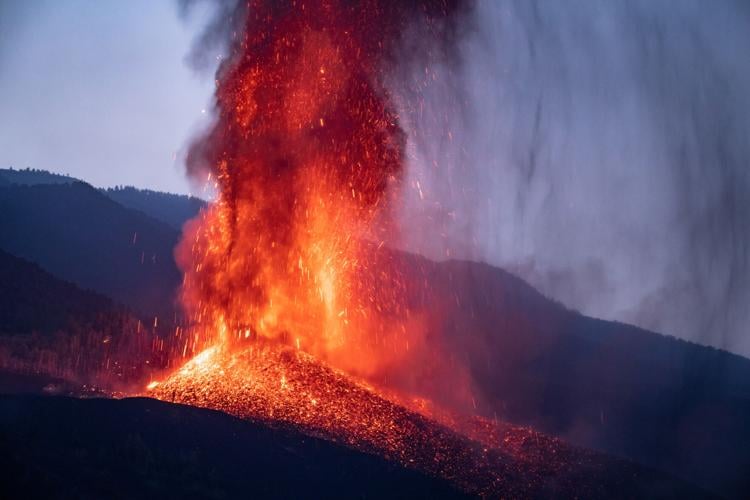After 50 years of little activity, the Cumbre Vieja volcano in La Palma, Spain sent a plume of toxic smoke into the sky in 2021. The eruption devastated the surrounding area with a barrage of ash and molten lava that did not end for 85 days.
Natural disasters like this one may seem quite distant from Colorado, but did you know that the Centennial State is home to several volcanos? In fact, the state's volcanic past is widely responsible the diverse topography that can be found in Colorado today.
Here's a brief look at a few volcanic spots worth talking about:
1. La Garita Caldera

La Garita Caldera is a 22-mile wide and 62-mile long depression in the landscape of the San Juan Mountains. Some scientific accounts suggest that the site was home to the largest volcanic eruption in Earth's history.
A caldera is formed when a pressure-caused eruption is so powerful the volcano itself collapses as a result.
The La Garita Caldera eruption happened an estimated 28 million years ago. "...it created the San Juan Mountains we know today by utterly destroying the volcanoes that stood here before," the United States Geological Survey (USGS) said in a report.
"La Garita blew a hole in the State of Colorado you could have seen from space, a glowing red wound as large as all of Mineral County," the report reads.
Today, La Garita Caldera is considered extinct, but its power can still be observed by the dramatic geological changes it left behind.
2. Dotsero

This zoomed aerial image gives a better look at the shape of Dotsero Crater. Photo Credit: @2019 Google Maps.
Dotsero – located in northwest Colorado near the junction of the Eagle River and the Colorado River – is the last active volcano in Colorado.
For a volcano to be considered extinct it can not have erupted in the last 10,000 years. Dotsero last erupted only about 4,152 years ago.
The Dotsero marr is around 700 meters wide and around 400 meters deep.
"A maar is a low-relief, broad volcanic crater formed by shallow explosive eruptions. The explosions are usually caused by the heating and boiling of groundwater when magma invades the groundwater table. Maars often fill with water to form a lake," the USGS said on their website.
Though an eruption in not expected anytime soon, the USGS has classified Dotsero has a moderate threat.
Today, the site attracts many hikers and lava flow from the last eruption is actually crossed by drivers on I-70.
3. Huerfano Butte

Photo credit: Maxfocus. File Photo. (iStock).
The Huerfano Butte is a volcanic plug located about 10 miles from Walsenburg, Colorado in Huerfano County. It has been called "the volcano that never was" because despite its volcanic potential, there is no geological proof that it ever erupted.
A volcanic plug or neck is formed when magma solidifies inside the vent of a volcano.
"When viewed from a distance, Huerfano Butte appears to be a volcanic neck, but there is no evidence that the magmas associated with Huerfano Butte vented to the surface," SpanishPeaksCountry.com said in a report.
Today, it is unlikely that volcanic activity will return to the plug.
4. Guffey Volcanic Center
Scientists believe that 34 million years ago, the Guffey Volcanic Center, located in Teller County and near Pikes Peak, was home to a series of stratovolcanoes similar in power and structure to Mount Saint Helens.
"When these volcanoes erupted, they would send lava and debris flows down into the paleovalleys beneath. McIntyre Mountain and Witcher Mountain are remnants of these massive flows," the National Park Service (NPS) said in an article about the center.
Guffey eruptions sent lahars – volcanic mudflows – into the surrounding valleys, the results of which can still be observed today.
"One lahar flowed eastward from the slopes of the Guffey volcanic center. There, it intersected the stream of the Florissant paleovalley, damming the flow and creating Lake Florissant," NPS said.
Another flow flooded the valley and petrified the stumps of the redwood trees that once grew there. These Late Cretaceous period stumps can still be visited today, seen by visitors along with a number of fossilized plants and insects.

The Big Stump, as it is known at Florissant Fossil Beds, rests beside the Petrified Forest Loop Trail. It is but one redwood remaining from some 34 million years ago, when this Teller Country area looked more tropical. Photo Credit: Seth Boster, The Gazette
Here are the few other places to visit in Colorado, that have a volcanic past:
- Thirty-nine Mile Volcanic Field—northwest of Cripple Creek
- Goemmer Butte—between the West Spanish Peak and the Sangre de Cristo Mountains
- North Table Mountain—on the eastern flank of the Front Range
- San Juan Volcanic Field—in the San Juan Mountains
STAY INFORMED: Sign-up for the daily OutThere Colorado newsletter here













(0) comments
Welcome to the discussion.
Log In
Keep it Clean. Please avoid obscene, vulgar, lewd, racist or sexually-oriented language.
PLEASE TURN OFF YOUR CAPS LOCK.
Don't Threaten. Threats of harming another person will not be tolerated.
Be Truthful. Don't knowingly lie about anyone or anything.
Be Nice. No racism, sexism or any sort of -ism that is degrading to another person.
Be Proactive. Use the 'Report' link on each comment to let us know of abusive posts.
Share with Us. We'd love to hear eyewitness accounts, the history behind an article.